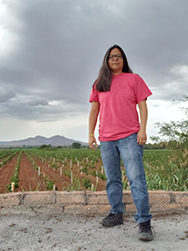North, South, and the InBetween
The San Andreas Fault is a place where two divergent fault lines touch moving
North and South.
I – primavera
My grandfather is a ninety-seven year old man who traveled North
for the first time in his late twenties in the company of
paisanos from the pueblos of Guanajuato,
Zacatecas, Michoacán, and other landlocked states and as he passed
inspection and peeked at the ocean for the first time outside of San Diego
felt desperately alone in a bus full of braceros who had left
their growing families, worried mothers, and a small town
with a plaza square where the old men from
surrounding ranchitos came to play baraja and talk about the
animals in their corrals, the fields they could no longer plough,
the grown children who had left to el Norte, and the weather.
II – verano
Abuelo made the trip North a second time in his mid thirties
when his two sons were not quite men
but were old enough to take care of Abuela.
Working the fields outside of Salinas, Abuelo inspected the thick
petals of an artichoke and surely wondered what other beauties
his poverty would never show him. The routine of constant
work was alleviated by a new found love of baseball,
a distance from disapproving glares, and the attention of women;
mujeres sinvergüenzas as Abuela would call them.
Two seasons later, Abuelo traveled South on a bus
full of weary men who had been lured
North to a foreign land with the promise of labor and were now
en route to a place they once called home feeling
something other than their sweat had been left behind in a field
barren from too many harvests. Rumbling through a ghost town
outside of the San Bernardino county line,
Abuelo vowed never to return.
III – otoño
My father ventured up to California in the late seventies,
like his father did once, leaving behind a young wife,
a family of five, and a cheerless mother whose husband
was dead only to her after Abuelo took up with a woman
and her four children. Papá worked a steady job
laundering sheets and gowns in the basement
of a large hospital in the Inland Empire.
Two years later, Papá would send for us to go live in Corona.
Before we left on the three-day bus ride in the fall of seventy-nine
Mamá went to receive blessings from abuelita Toña and
my last memory of home was getting lost amongst
the giant sunflowers in the field behind abuelita’s adobe
made of baked-earth bricks hardened by a day’s fire
in the open ground next to a thinning crop of maize, calabaza, and frijol.
IV – invierno
On his third visit North, Abuelo came to visit
my father in his death bed, thirty eight years after
walking away, despite Abuela’s threats,
from the modest home he had helped build with
his two grown sons for their wives and brood of children
that ran wild in the courtyard chasing the chickens
for fun but who cried when told the caged rabbits were only for food.
Papá, with tubes snaking from his body and puffy
from chemicals, listened as Abuelo talked about baseball,
relatives who had since passed, the work
he had once tended to, and the weather.
Holding Papá’s left hand, translucent in his palm,
Abuelo was astounded by the small purple veins visible
underneath the delicate skin reminiscent of the wondrous
artichoke in bloom he once held in a field outside of Salinas.
– Laura Araujo S.
_____________________________________________________________
LAND-ARTPROJECT COLLABORATION
Poem by Laura Araujo S.
Music by DjR3X
Photography by Jacalyn Lopez Garcia

Selfie of the Artist
BACK to Cyber GALLERY/ Photo Gallery
